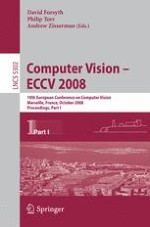Welcome to the 2008EuropeanConference onComputer Vision. These proce- ings are the result of a great deal of hard work by many people. To produce them, a total of 871 papers were reviewed. Forty were selected for oral pres- tation and 203 were selected for poster presentation, yielding acceptance rates of 4.6% for oral, 23.3% for poster, and 27.9% in total. Weappliedthreeprinciples.First,sincewehadastronggroupofAreaChairs, the ?nal decisions to accept or reject a paper rested with the Area Chair, who wouldbeinformedbyreviewsandcouldactonlyinconsensuswithanotherArea Chair. Second, we felt that authors were entitled to a summary that explained how the Area Chair reached a decision for a paper. Third, we were very careful to avoid con?icts of interest. Each paper was assigned to an Area Chair by the Program Chairs, and each Area Chair received a pool of about 25 papers. The Area Chairs then identi?ed and rankedappropriatereviewersfor eachpaper in their pool, and a constrained optimization allocated three reviewers to each paper. We are very proud that every paper received at least three reviews. At this point, authors were able to respond to reviews. The Area Chairs then needed to reach a decision. We used a series of procedures to ensure careful review and to avoid con?icts of interest. ProgramChairs did not submit papers. The Area Chairs were divided into three groups so that no Area Chair in the group was in con?ict with any paper assigned to any Area Chair in the group.
